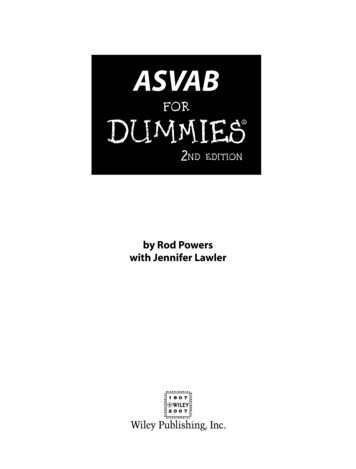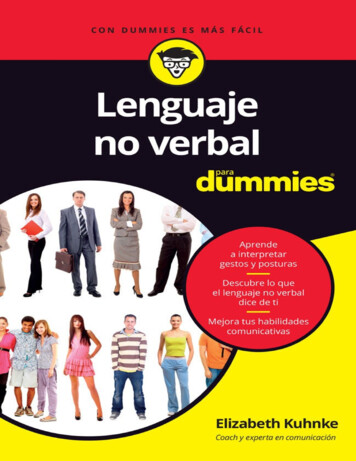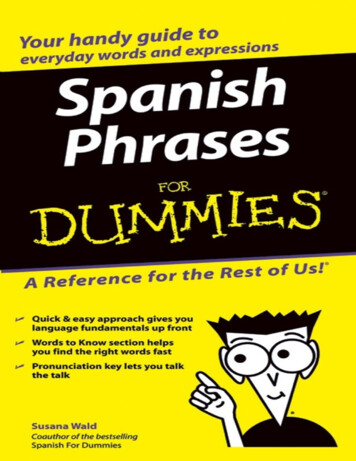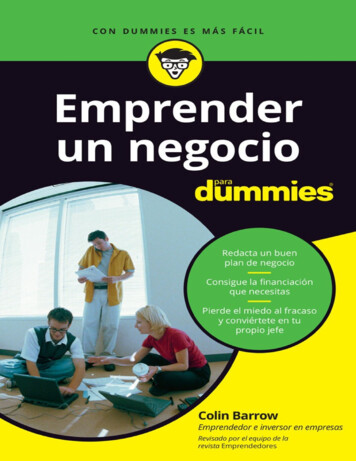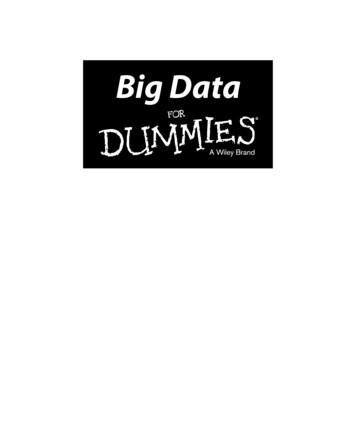
Transcription
Circuit Analysis
Circuit Analysisby John M. Santiago, Jr., PhDProfessor of Electrical and SystemsEngineering, Colonel (Ret) USAF
Circuit Analysis For Dummies Published byJohn Wiley & Sons, Inc.111 River St.Hoboken, NJ 07030-5774www.wiley.comCopyright 2013 by John Wiley & Sons, Inc., Hoboken, New JerseyPublished by John Wiley & Sons, Inc., Hoboken, New JerseyPublished simultaneously in CanadaNo part of this publication may be reproduced, stored in a retrieval system or transmitted in any formor by any means, electronic, mechanical, photocopying, recording, scanning or otherwise, except aspermitted under Sections 107 or 108 of the 1976 United States Copyright Act, without the prior writtenpermission of the Publisher. Requests to the Publisher for permission should be addressed to thePermissions Department, John Wiley & Sons, Inc., 111 River Street, Hoboken, NJ 07030, (201) 748-6011,fax (201) 748-6008, or online at http://www.wiley.com/go/permissions.Trademarks: Wiley, the Wiley logo, For Dummies, the Dummies Man logo, A Reference for the Rest of Us!,The Dummies Way, Dummies Daily, The Fun and Easy Way, Dummies.com, Making Everything Easier,and related trade dress are trademarks or registered trademarks of John Wiley & Sons, Inc., and/or itsaffiliates in the United States and other countries, and may not be used without written permission. Allother trademarks are the property of their respective owners. John Wiley & Sons, Inc., is not associatedwith any product or vendor mentioned in this book.LIMIT OF LIABILITY/DISCLAIMER OF WARRANTY: THE PUBLISHER AND THE AUTHOR MAKE NOREPRESENTATIONS OR WARRANTIES WITH RESPECT TO THE ACCURACY OR COMPLETENESSOF THE CONTENTS OF THIS WORK AND SPECIFICALLY DISCLAIM ALL WARRANTIES, INCLUDINGWITHOUT LIMITATION WARRANTIES OF FITNESS FOR A PARTICULAR PURPOSE. NO WARRANTYMAY BE CREATED OR EXTENDED BY SALES OR PROMOTIONAL MATERIALS. THE ADVICE ANDSTRATEGIES CONTAINED HEREIN MAY NOT BE SUITABLE FOR EVERY SITUATION. THIS WORK ISSOLD WITH THE UNDERSTANDING THAT THE PUBLISHER IS NOT ENGAGED IN RENDERING LEGAL,ACCOUNTING, OR OTHER PROFESSIONAL SERVICES. IF PROFESSIONAL ASSISTANCE IS REQUIRED,THE SERVICES OF A COMPETENT PROFESSIONAL PERSON SHOULD BE SOUGHT. NEITHER THEPUBLISHER NOR THE AUTHOR SHALL BE LIABLE FOR DAMAGES ARISING HEREFROM. THE FACTTHAT AN ORGANIZATION OR WEBSITE IS REFERRED TO IN THIS WORK AS A CITATION AND/ORA POTENTIAL SOURCE OF FURTHER INFORMATION DOES NOT MEAN THAT THE AUTHOR OR THEPUBLISHER ENDORSES THE INFORMATION THE ORGANIZATION OR WEBSITE MAY PROVIDE ORRECOMMENDATIONS IT MAY MAKE. FURTHER, READERS SHOULD BE AWARE THAT INTERNETWEBSITES LISTED IN THIS WORK MAY HAVE CHANGED OR DISAPPEARED BETWEEN WHEN THISWORK WAS WRITTEN AND WHEN IT IS READ.For general information on our other products and services, please contact our Customer CareDepartment within the U.S. at 877-762-2974, outside the U.S. at 317-572-3993, or fax 317-572-4002.For technical support, please visit www.wiley.com/techsupport.Wiley publishes in a variety of print and electronic formats and by print-on-demand. Some materialincluded with standard print versions of this book may not be included in e-books or in print-on-demand.If this book refers to media such as a CD or DVD that is not included in the version you purchased, youmay download this material at http://booksupport.wiley.com. For more information about Wileyproducts, visit www.wiley.com.Library of Congress Control Number: 2013932101ISBN 978-1-118-49312-0 (pbk); ISBN 978-1-118-59050-8 (ebk); ISBN 978-1-118-59052-2 (ebk);ISBN 978-1-118-59056-0 (ebk)Manufactured in the United States of America10 9 8 7 6 5 4 3 2 1
About the AuthorJohn Santiago retired from the military in 2003 with 26 years of service inthe United States Air Force (USAF). John has served in a variety of leadershippositions in technical program management, acquisition development,and operation research support. While assigned in Europe for three yearswith the USAF, he spearheaded more than 40 international scientific andengineering conferences/workshops as a steering committee member.John has experience in many engineering disciplines and missions, includingcontrol and modeling of large, flexible space structures; communicationssystems; electro-optics; high-energy lasers; missile seekers/sensors forprecision-guided munitions; image processing/recognition; informationtechnologies; space, air, and missile warning; missile defense; and homelanddefense.One of John’s favorite assignments was serving as an associate professor atthe USAF Academy during his tour from 1984 through 1989. John is currentlya professor of Electrical and Systems Engineering at Colorado TechnicalUniversity, where he has taught 26 different undergraduate and graduatecourses in electrical and systems engineering.Some of his awards include Faculty of the Year at Colorado TechnicalUniversity in 2008; USAF Academy Outstanding Military Educator in 1989; andUSAF Academy Outstanding Electrical Engineering Educator in 1998.During his USAF career, John received his PhD in Electrical Engineering fromthe University of New Mexico; his Master of Science in Resource Strategy atthe Industrial College of the Armed Forces; his Master of Science in ElectricalEngineering from the Air Force Institute of Technology, specializing inelectro-optics; and his Bachelor of Science from the University of California,Los Angeles.On February 14, 1982, John married Emerenciana F. Manaois.More information about John’s background and experience is available atwww.FreedomUniversity.TV.
DedicationTo my heavenly Father, thank you for all the many blessings, especially thegift of family and friends.To my lovely Emily, thank you for your loving and continued support, alwaysand forever.To my parents, who bravely immigrated here from the Philippines to live inthis great nation.To the Founding Fathers, who were engineers and visionary leaders increating this great country called the United States. To their creative geniusand to all those standing on their shoulders, especially the next generation ofengineers.To all those who wondered if there’s anything more to circuit analysis thanOhm’s law and Kirchhoff’s laws.Author’s AcknowledgmentsMany people have been involved in this book, and I thank them all. First, toall the former cadets at the United States Air Force Academy, the students atthe University of West Florida, and the students at the Colorado TechnicalUniversity who endured my class lessons and asked a gazillion questionsover the years as I continued to learn to become a better teacher.I’d like to thank a team of players who’ve made my writing presentable.First, I’d like to thank Matt Wagner, my agent, who contacted me aboutwriting this book. I’d also especially like to thank the folks at Wiley who madethis book possible: Erin Mooney, my acquisitions editor; Jennifer Tebbe, myproject editor; and Danielle Voirol, my copy editor.I’d again like to thank my wife for her encouragement and for keeping mestraight about the things going on at home and in the community as I wentthrough this writing adventure.
Publisher’s AcknowledgmentsWe’re proud of this book; please send us your comments at http://dummies.custhelp.com. Forother comments, please contact our Customer Care Department within the U.S. at 877-762-2974,outside the U.S. at 317-572-3993, or fax 317-572-4002.Some of the people who helped bring this book to market include the following:Acquisitions, Editorial, andVertical WebsitesComposition ServicesProject Editor: Jennifer TebbeAcquisitions Editor: Erin Calligan MooneySenior Copy Editor: Danielle VoirolAssistant Editor: David LuttonEditorial Program Coordinator: Joe NiesenProject Coordinator: Katherine CrockerLayout and Graphics: Carl Byers,Carrie A. Cesavice, Amy Hassos,Joyce Haughey, Christin SwinfordProofreaders: Tricia Liebig, Dwight RamseyIndexer: Ty KoontzTechnical Editor: Chang Liu, Dan MooreEditorial Manager: Christine Meloy BeckEditorial Assistant: Alexa Koschier,Rachelle S. AmickCover Photo: VOLODYMYR GRINKO/iStockphoto.comPublishing and Editorial for Consumer DummiesKathleen Nebenhaus, Vice President and Executive PublisherDavid Palmer, Associate PublisherKristin Ferguson-Wagstaffe, Product Development DirectorPublishing for Technology DummiesAndy Cummings, Vice President and PublisherComposition ServicesDebbie Stailey, Director of Composition Services
Contents at a GlanceIntroduction. 1Part I: Getting Started with Circuit Analysis. 5Chapter 1: Introducing Circuit Analysis. 7Chapter 2: Clarifying Basic Circuit Concepts and Diagrams. 15Chapter 3: Exploring Simple Circuits with Kirchhoff’s Laws. 25Chapter 4: Simplifying Circuit Analysis with Source Transformationand Division Techniques. 41Part II: Applying Analytical Methodsfor Complex Circuits. 65Chapter 5: Giving the Nod to Node-Voltage Analysis. 67Chapter 6: Getting in the Loop on Mesh Current Equations. 83Chapter 7: Solving One Problem at a Time Using Superposition. 95Chapter 8: Applying Thévenin’s and Norton’s Theorems. 113Part III: Understanding Circuits with Transistorsand Operational Amplifiers. 131Chapter 9: Dependent Sources and the Transistors That Involve Them. 133Chapter 10: Letting Operational Amplifiers Do the Tough Math Fast. 155Part IV: Applying Time-Varying Signalsto First- and Second-Order Circuits. 173Chapter 11: Making Waves with Funky Functions. 175Chapter 12: Spicing Up Circuit Analysis with Capacitors and Inductors. 193Chapter 13: Tackling First-Order Circuits. 211Chapter 14: Analyzing Second-Order Circuits. 233Part V: Advanced Techniques andApplications in Circuit Analysis. 253Chapter 15: Phasing in Phasors for Wave Functions. 255Chapter 16: Predicting Circuit Behavior with Laplace Transform Techniques. 273Chapter 17: Implementing Laplace Techniques for Circuit Analysis. 295Chapter 18: Focusing on the Frequency Responses. 313
Part VI: The Part of Tens. 335Chapter 19: Ten Practical Applications for Circuits. 337Chapter 20: Ten Technologies Affecting Circuits. 341Index. 345
Table of ContentsIntroduction. 1About This Book. 1Conventions Used in This Book. 1What You’re Not to Read. 2Foolish Assumptions. 2How This Book Is Organized. 2Part I: Getting Started with Circuit Analysis. 2Part II: Applying Analytical Methods for Complex Circuits. 3Part III: Understanding Circuits with Transistorsand Operational Amplifiers.3Part IV: Applying Time-Varying Signalsto First- and Second-Order Circuits. 3Part V: Advanced Techniques andApplications in Circuit Analysis. 3Part VI: The Part of Tens. 3Icons Used in This Book. 4Where to Go from Here. 4Part I: Getting Started with Circuit Analysis. 5Chapter 1: Introducing Circuit Analysis . . . . . . . . . . . . . . . . . . . . . . . . . . 7Getting Started with Current and Voltage. 7Going with the flow with current. 8Recognizing potential differences with voltage. 9Staying grounded with zero voltage. 9Getting some direction with the passive sign convention. 10Beginning with the Basic Laws. 11Surveying the Analytical Methods for More-Complex Circuits. 11Introducing Transistors and Operational Amplifiers. 12Dealing with Time-Varying Signals, Capacitors, and Inductors. 13Avoiding Calculus with Advanced Techniques. 13Chapter 2: Clarifying Basic Circuit Concepts and Diagrams . . . . . . . . 15Looking at Current-Voltage Relationships. 15Absorbing energy with resistors. 16Applying Ohm’s law to resistors. 16Calculating the power dissipated by resistors. 18Offering no resistance: Batteries and short circuits. 18Batteries: Providing power independently. 19Short circuits: No voltage, no power. 19
xiiCircuit Analysis For DummiesFacing infinite resistance: Ideal currentsources and open circuits. 20All or nothing: Combining open andshort circuits with ideal switches. 20Mapping It All Out with Schematics. 21Going in circles with loops. 22Getting straight to the point with nodes. 24Chapter 3: Exploring Simple Circuits with Kirchhoff’s Laws . . . . . . . 25Presenting Kirchhoff’s Famous Circuit Laws. 25Kirchhoff’s voltage law (KVL): Conservation of energy. 26Identifying voltage rises and drops. 26Forming a KVL equation. 27Kirchhoff’s current law (KCL): Conservation of charge. 29Tracking incoming and outgoing current. 29Calculating KCL. 30Tackling Circuits with KVL, KCL, and Ohm’s Law. 31Getting batteries and resistors to work together. 31Starting with voltage. 32Bringing in current. 32Combining device equations with KVL. 33Summarizing the results. 34Sharing the same current in series circuits. 34Climbing the ladder with parallel circuits. 36Describing total resistance using conductance. 37Using a shortcut for two resistors in parallel. 38Finding equivalent resistor combinations. 38Combining series and parallel resistors. 40Chapter 4: Simplifying Circuit Analysis with SourceTransformation and Division Techniques . . . . . . . . . . . . . . . . . . . . . . . . 41Equivalent Circuits: Preparing for the Transformation. 42Transforming Sources in Circuits. 45Converting to a parallel circuit with a current source. 45Changing to a series circuit with a voltage source. 47Divvying It Up with the Voltage Divider. 49Getting a voltage divider equation for a series circuit. 49Figuring out voltages for a series circuitwith two or more resistors. 51Finding voltages when you have multiple current sources. 52Using the voltage divider technique repeatedly. 55Cutting to the Chase Using the Current Divider Technique. 57Getting a current divider equation for a parallel circuit. 57Figuring out currents for parallel circuits. 59Finding currents when you have multiple voltage sources. 60Using the current divider technique repeatedly. 63
Table of ContentsPart II: Applying Analytical Methodsfor Complex Circuits. 65Chapter 5: Giving the Nod to Node-Voltage Analysis . . . . . . . . . . . . . . 67Getting Acquainted with Node Voltages and Reference Nodes. 67Testing the Waters with Node Voltage Analysis. 69What goes in must come out: Starting with KCL at the nodes. 70Describing device currents in termsof node voltages with Ohm’s law. 70Putting a system of node voltage equations in matrix form. 72Solving for unknown node voltages. 73Applying the NVA Technique. 74Solving for unknown node voltageswith a current source. 74Dealing with three or more node equations. 76Working with Voltage Sources in Node-Voltage Analysis. 80Chapter 6: Getting in the Loop on Mesh Current Equations . . . . . . . . . 83Windowpanes: Looking at Meshes and Mesh Currents. 83Relating Device Currents to Mesh Currents. 84Generating the Mesh Current Equations. 86Finding the KVL equations first. 87Ohm’s law: Putting device voltages in terms of mesh currents. 87Substituting the device voltages into the KVL equations. 88Putting mesh current equations into matrix form. 89Solving for unknown currents and voltages. 89Crunching Numbers: Using Meshes to Analyze Circuits. 90Tackling two-mesh circuits. 90Analyzing circuits with three or more meshes. 92Chapter 7: Solving One Problem at a Time Using Superposition . . . . 95Discovering How Superposition Works. 95Making sense of proportionality. 96Applying superposition in circuits. 98Adding the contributions of each independent source. 100Getting Rid of the Sources of Frustration. 101Short circuit: Removing a voltage source. 101Open circuit: Taking out a current source. 102Analyzing Circuits with Two Independent Sources. 103Knowing what to do when the sources are two voltage sources.103Proceeding when the sources are two current sources. 105Dealing with one voltage source and one current source. 107Solving a Circuit with Three Independent Sources. 108xiii
xivCircuit Analysis For DummiesChapter 8: Applying Thévenin’s and Norton’s Theorems . . . . . . . . . . 113Showing What You Can Do with Thévenin’sand Norton’s Theorems. 114Finding the Norton and Thévenin Equivalentsfor Complex Source Circuits. 115Applying Thévenin’s theorem. 117Finding the Thévenin equivalent of a circuitwith a single independent voltage source. 117Applying Norton’s theorem. 119Using source transformation to find Thévenin or Norton. 122A shortcut: Finding Thévenin or Nortonequivalents with source transformation. 122Finding the Thévenin equivalent of a circuitwith multiple independent sources. 122Finding Thévenin or Norton with superposition. 124Gauging Maximum Power Transfer: A PracticalApplication of Both Theorems. 127Part III: Understanding Circuits with Transistorsand Operational Amplifiers. 131Chapter 9: Dependent Sources andthe Transistors That Involve Them . . . . . . . . . . . . . . . . . . . . . . . . . . . . . 133Understanding Linear Dependent Sources: Who Controls What. 134Classifying the types of dependent sources. 134Recognizing the relationship between dependentand independent sources. 136Analyzing Circuits with Dependent Sources. 136Applying node-voltage analysis. 137Using source transformation. 138Using the Thévenin technique. 140Describing a JFET Transistor with a Dependent Source. 142Examining the Three Personalities of Bipolar Transistors. 145Making signals louder with the common emitter circuit. 146Amplifying signals with a common base circuit. 149Isolating circuits with the common collector circuit. 151Chapter 10: Letting Operational AmplifiersDo the Tough Math Fast . . . . . . . . . . . . . . . . . . . . . . . . . . . . . . . . . . . . . . 155The Ins and Outs of Op-Amp Circuits. 155Discovering how to draw op amps. 156Looking at the ideal op amp and its transfer characteristics. 157Modeling an op amp with a dependent source. 158Examining the essential equations foranalyzing ideal op-amp circuits. 159
Table of ContentsLooking at Op-Amp Circuits. 160Analyzing a noninverting op amp. 160Following the leader with the voltage follower. 162Turning things around with the inverting amplifier. 163Adding it all up with the summer. 164What’s the difference? Using the op-amp subtractor. 166Increasing the Complexity of What You Can Do with Op Amps. 168Analyzing the instrumentation amplifier. 168Implementing mathematical equations electronically. 170Creating systems with op amps. 171Part IV: Applying Time-Varying Signalsto First- and Second-Order Circuits. 173Chapter 11: Making Waves with Funky Functions . . . . . . . . . . . . . . . 175Spiking It Up with the Lean, Mean Impulse Function. 176Changing the strength of the impulse. 178Delaying an impulse. 178Evaluating impulse functions with integrals. 179Stepping It Up with a Step Function. 180Creating a time-shifted, weighted step function. 181Being out of step with shifted step functions. 182Building a ramp function with a step function. 182Pushing the Limits with the Exponential Function. 184Seeing the Signs with Sinusoidal Functions. 186Giving wavy functions a phase shift. 187Expanding the function and finding Fourier coefficients. 189Connecting sinusoidal functions to exponentialswith Euler’s formula. 190Chapter 12: Spicing Up Circuit Analysiswith Capacitors and Inductors . . . . . . . . . . . . . . . . . . . . . . . . . . . . . . . . 193Storing Electrical Energy with Capacitors. 193Describing a capacitor. 194Charging a capacitor (credit cards not accepted). 195Relating the current and voltage of a capacitor. 195Finding the power and energy of a capacitor. 196Calculating the total capacitance forparallel and series capacitors. 199Finding the equivalent capacitanceof parallel capacitors. 199Finding the equivalent capacitanceof capacitors in series. 200Storing Magnetic Energy with Inductors. 200Describing an inductor. 201Finding the energy storage of an attractive inductor. 202xv
xviCircuit Analysis For DummiesCalculating total inductance for seriesand parallel inductors. 203Finding the equivalent inductancefor inductors in series. 203Finding the equivalent inductancefor inductors in parallel. 204Calculus: Putting a Cap on Op-Amp Circuits. 205Creating an op-amp integrator. 205Deriving an op-amp differentiator. 207Using Op Amps to Solve Differential Equations Really Fast. 208Chapter 13: Tackling First-Order Circuits . . . . . . . . . . . . . . . . . . . . . . . 211Solving First-Order Circuits with Diff EQ. 211Guessing at the solution with thenatural exponential function. 213Using the characteristic equation for a first-order equation. 214Analyzing a Series Circuit with a Single Resistor and Capacitor. 215Starting with the simple RC series circuit. 215Finding the zero-input response . 217Finding the zero-state response byfocusing on the input source. 219Adding the zero-input and zero-state responsesto find the total response. 222Analyzing a Parallel Circuit with a Single Resistor and Inductor. 224Starting with the simple RL parallel circuit. 225Calculating the zero-input response for an RL parallel circuit. 226Calculating the zero-state response for an RL parallel circuit. 228Adding the zero-input and zero-state responsesto find the total response. 230Chapter 14: Analyzing Second-Order Circuits . . . . . . . . . . . . . . . . . . . 233Examini
Publishing and Editorial for Consumer Dummies Kathleen Nebenhaus, Vice President and Executive Publisher David Palmer, Associate Publisher Kristin Ferguson-Wagstaffe, Product Development Director Publishing for Technology Dummies Andy Cummings, Vice President and Publisher Composition Services Debbie Stailey, Director of Composition Services




